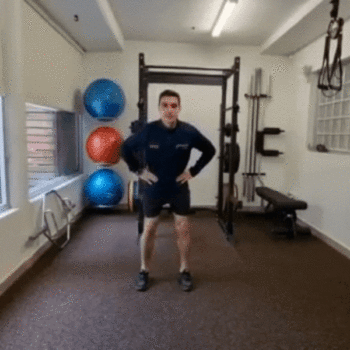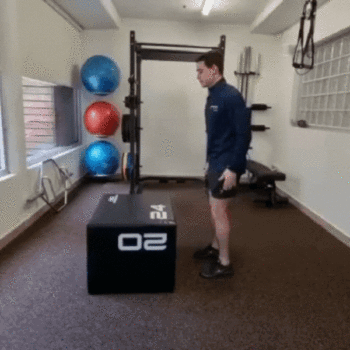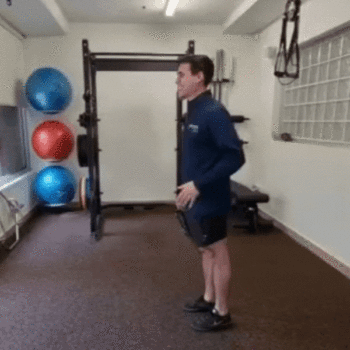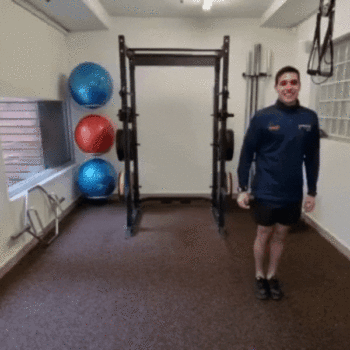Plyometric training involves performing explosive, powerful movements. Significant force development is required in a minimal period to allow explosive movement’s to be executed. When performing plyometric training or “plyo’s”, predominantly lower limb muscles are trained and under great tension and force.
Vertical jumping is a vital component of explosive performance, which is required when performing countless athletic movement patterns. Jumping performance is pivotal when executing numerous explosive skills requiring high force output, such as rebounding in basketball, heading in football, and serving in tennis.
Implementing exercises which closely mimic movement patterns required within a specific sports are encouraged to be performed.
Plyometric exercises are extremely beneficial in enhancing explosive performance, which may lead to an athlete gaining a competitive advantage over their opposition.
Plyometrics are not only beneficial if trying to improve vertical jump height or performing a sport specific movement. They also allow for lower limb musculature to adapt to greater forces and load and beneficially enhance force absorption, and force attenuating capacity.
Improvements in power achieved from performing plyo’s can directly translate to improved performance and give an athlete a competitive advantage over their opposition.
Benefits on Combining Plyometrics With Other Exercises
A commonly asked question is whether implementing plyometric exercises along with other types of exercise is beneficial or detrimental.
So, here goes…
1- Resistance Training
Implementing both plyometric and resistance exercises is recommended to enhance and maximise both muscular strength and power. A combination of plyometric training and weight training has been seen to be most beneficial in improving vertical jump height (Fatouros et al. 2000).
2 – Cardiorespiratory Exercise
Performing plyometric exercises can lead to improvements in aerobic exercise performance. Greater force attenuating capacity, enhancements in lower limb strength, power and agility will positively influence gait and movement patterning e.g. hip flexion and ankle plantarflexion.
Improved movement pattern efficiency can benefit aerobic performance through decreased physical fatigue.
When Are Plyometric Exercises Most Commonly Prescribed
Implementing sport or movement specific plyos can be extremely beneficial in enhancing efficiency of movement patterns and decrease energy expenditure. Limiting energy expenditure and increasing movement pattern efficiency is vital, particularly in sport settings to reduce physical fatigue, and maximise performance.
Plyometric exercises are commonly implemented in rehabilitative setting, specifically when an individual/athlete is required to return to movement patterns which involve greater impact and require increased absorption of forces.
Performing a graded, gradual exercise program when returning to sport is vital to enhance a smooth transition back to exercise/sport and reduce risk of re-injury.
Precautions When Performing Plyometric Exercises
Be cautious when implementing plyometrics’ into your workout routine if you have minimal training experience, have any injuries or chronic conditions. Consider the following factors before implementing these exercises into your training regime.
1 – Gradual Implementation
Plyometric exercises require strong, durable ligaments and tendons as they can cause significant stress to joints. Gradual implementation and progression is of vital importance, therefore it is recommended to initially perform less complicated, lower intensity exercises and progress accordingly.
As plyo’s involve significant force exertion, it is often recommended to perform 3 sets of 6-8 repetitions initially. Sets and reps can be gradually increased as familiarity and efficiency of movement patterns improves, ensuring adequate form is sustained.
2 – Adequate Rest Periods
When performing plyometric exercises, ensure adequate rest periods between sets are implemented to maintain form and allow adequate muscle recovery.
Rest periods of ~1-2 minutes should be implemented when first undertaking plyo’s, with rest periods gradually decreasing to 1 minute with increased efficiency and familiarity of movement is achieved.
3 – Form is Vital
It is often beneficial to record the plyometric exercises to assess movement patterns and identify compensations which may be present. Assessing form and implementing slight modifications to form will enhance force absorption and landing mechanics.
Compensations are more likely to occur when fatigue onset’s, leading to increased injury risk. Therefore, adequate form is required when performing plyo’s to achieve meaningful outcomes.
Try Implementing These Plyometric Exercises Into Your Training
Here are four effective plyometric exercises to incorporate into your training protocol.
Countermovement Jump
- Start by placing your feet at a shoulder width apart with hands on hips.
- Slowly bend your knees and lower down into a squat position, a 90 degree angle is ideal.
- Perform an explosive jump and keep hand on hips throughout the movement.
- Execute a controlled landing with feet a shoulder width apart, and lower back down to a squatting position.
Front Box Jump
- Place feet at a shoulder’s width apart and slowly lower into a squat position.
- Perform an explosive jump by activating glute, quadricep and calf musculature.
- Execute a controlled landing in a half squat position by absorbing contact through bilateral knee flexion and ensure feet are placed at a shoulder’s width apart.
Askips
- Start by placing your feet at a shoulder width apart
- Simultaneously perform 3 explosive alternating knee drives with calf raises in a sequence.
- Continue to perform the movement with minimal rest periods for a total of 12-20 repetitions (6-10 each side).
Lateral Bounds
- Start by standing on one leg in a half squat position.
- Perform an explosive lateral jump in the direction of the non-planted leg.
- Execute a controlled landing in a single leg half squat position with adequate force absorption. Ensure the knee and foot are aligned on the landing leg.
- Once confident with form, gradually increase lateral jump distance.
Want To Know More?
We’d suggest contacting our team at Precision Physio, so that we can help you with your individual case.
How Do I Book An Appointment?
We’re taking the health of our clients, members and staff very seriously and our preference would be for you to call to book an appointment so that we can make sure to explain our approach to keeping you safe. You can call any of these numbers to schedule a session:
- Precision Physio Concord: 02 9736 3950
- Precision Physio St Marys: 02 9623 2220
- Precision Physio Mt Druitt: 02 9188 2552
Online Consultations
Evolving with the current environment, we are also now offering online appointments, meaning that we can support anyone who is unable to leave their home. Sessions are done via our state of the art Telehealth system and as long as you have a laptop or tablet with an inbuilt camera, or a phone with camera, we can help!
To learn more about online consultations, please call us on any of the numbers listed above.




